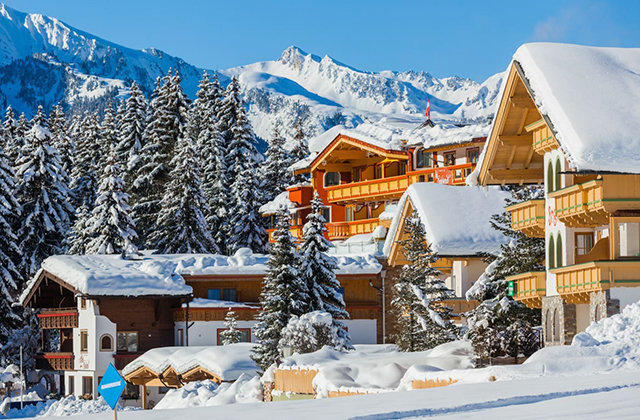This is also where you get the ultra-dry snow that Canada is famous for and if it’s deep the skiing will be epic for those heli skiing Canada tourists. Skiers heading to the hills this winter used to have to make a big decision: “should we go downhill skiing at the resort?” Or should “we go cross country skiing at the lodge and get away from the crowds?” Well, from Europe comes a new alternative. Alpine Ski Touring –yes, you read that right: “Alpine” and “Touring” have merged in North America in a big way. What is Alpine Touring? Alpine Touring or “AT” as it called in the states, is the marriage of a downhill ski and a convertible binding that allows walking on the flat and a heel lift for climbing up hills. Combine all that with boots that flex like a soft shoe and “climbing skins” that provide slide and grip and viola!- you have the best of both worlds. Where as the terms “Alpine Ski Touring” or “AT” skiing are used more in America. The term “randonnée” is used more in France and literally means to “walk about”. Else where in Europe the simple term “touring” is used.
Why the sport is becoming so popular? In Europe, this sport has been around for decades. During the Spring, it is not unusual to see skiers from all over Europe descend upon the ski capital of the world: Chamonix, France to ski down The Valley Blanche- a 21 mile long glacier that starts off with one the longest tram rides in the world. Off course, it is not just the skiing, it is everything! The lunch of wine and cheese while admiring the views of the mountains on a beautiful Spring day. It is the quiet of the mountains away from the resort crowds. That is what makes more and more European skiers and now American skiers gravitate towards this wonderful sport.
Downhill skiers are shifting to AT gear in record numbers. And American and European ski manufacturers have taken notice. Downhill skiers now are trying “side country” where they venture onto areas that ski patrols are allowing skiers to enter that were previously closed due to avalanche danger. This is a way for resorts to expand their terrain offerings without constructing whole new runs or install new ski lifts. It is now estimated that over 3.7 North Americans are participating in the sport: an estimated growth of over 40% year over year! Sales of accessories such as skis, climbing skins and boots and bindings have grown from $9 million US to over $15 million US during the past 2011-12 winter season.
In 1996, I completed the only American scientific research into Alpine Ski Touring. In my doctoral dissertation, I stated that there was a growing shift to wider skis in the backcountry. This has occurred on a huge scale and has made non groomed snow easier and much more enjoyable to ski with fewer falls. I also pointed out that the AT binding was superior in its mechanical efficiency compared to the traditional cable Telemark binding. The AT binding is designed with mechanical pivot point that allows the binding to flex forward when you are walking. The mechanical pivot also allows for a more precise release mechanism that is safer and more predictable. It also makes the AT binding more efficient for climbing. It also opens up the options for an adjustable release binding that telemark bindings do not generally provide. The great appeal of the sport is that downhill Alpine skiers don’t have to learn a whole new technique like Telemarking to head to the backcountry. They already know how to parallel ski.Why learn a whole other ski technique when you can build on what you know? The fact is, most European skiers just use parallel techniques in the backcountry. Even telemark skiers use parallel techniques when on harder slopes. Alpine ski touring encourages the skier to solidify their “foundation” techiques such as Snow Plow, Stem Christi, Wide Stance Parallel turns and even the Kick Turn. These are some skills that are often brushed over by “modern” ski schools that try to get the skier to head downhill faster using “surfing” and “swiping” turns. They there by miss out on some small techniques that come in handy when they leave the un groomed slopes.
AT skiing is not just about skiing steep chutes or skiing off cliffs-as fun as can be for some. It’s also about skiing to a hut for a night out or having lunch on top of a peak during a beautiful Spring Day. It’s about skiing from one resort to the next. It’s about skiing untouched powder! Whether you are a resort skier looking to expand your horizons or a cross-country skier looking to see what the next step is. Alpine Ski Touring might be the next new adventure for you!
(For more information about Alpine Ski Touring go to Jean’s web site: [http://www.Skirandonnee.com]. Also look for his new upcoming book: The Handbook of Alpine Ski Touring due out in 2013 to be published by Pequot Press.)
Jean Vives Ed.D. has his degree in Exercise Physiology from the University of Northern Colorado. He has published over 25 articles in such sources as Ski, Skiing and Outside Magazine. His research on skiing won the Charles Houston Grant from the Wilderness Medical Society. He has skied and climbed all over the world. He has done sport science research as Everest Base Camp while teaching at Kathmandu University, Nepal. He has written several books on backcountry skiing. He is a guide and writer living near Boulder, Colorado. Look under “Jean Vives” for other helpful articles and links to other of his web sites such as [http://www.Skirandonnee.com]. His new book “Alpine SKi Touring Handbook” is due Fall,2013.
Article Source: https://EzineArticles.com/expert/Jean_R_Vives/1456499
Article Source: http://EzineArticles.com/7393138

